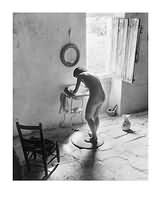
photography, writing, fine art... stuff ... other stuff ...
I am primarily interested in the figure, and in two aspects of it ... what I have called
the agonistic nude and the domestic nude. I am
particularly interested in the female nude, and in my response to it both as to a sexual
body, and as to a body with eirenic or even salvific potential.
One of the roots of the work I am doing is a project which has been under way for
roughly four years now, that is a photo-reportage project based in
the Western Bar, in Edinburgh.
Early in that project I settled on a private theme, which is based on the beginning of
John's Gospel in the New Testament: 'they beheld his glory, the glory as of the only
begotten of the father, full of grace and truth'. I am fascinated by this double quality
of grace and truth. Grace implies forgiveness, mercy, a willingness not to judge or
condemn; truth has a forensic, unremitting connotation. Yet the truth established,
told, and confronted is the beginning of healing.
So I am fascinated by the potential for both beauty and grace in what, following Auden, we might regard as a 'low-down dive'. This is in keeping with a theme from my poetry, as expressed for instance in 'Berwick Street' (Fool's Pardon, Faber, 1995). A strip bar or porn shop is one of the few places where a man is free of any pressure to dissemble; motives are unambiguous, for all present, and so none can condemn. It is a place where, to refer to another poem, a man can 'find good fellowship'.
Photography and the camera play a major role in my work. I am interested in the camera as an object, and as a theme for making sculpture. It represents the gaze, and at its heart is the black space or chamber (camera = chamber) the 'camera obscura' which, by its emptiness and neutrality, bears witness to history. It is the archetypal dark space ... the prison cell or dungeon, the heart of the crematorium, or even what we might romantically call 'the human heart'. I want to make work which takes the viewer inside that dark and neutral space. Hence the camera sculpture.
Besides the figure, weapons continue to be a significant theme. I hope to continue with blade-forging, and with photography which includes blades and the figure. Alongside the interest in weapons is an interest in execution, and of all executions, the traditional Christian theme of the Passion remains central. It is archetypal of the agonistic nude.
Weapons and the figure both have a double quality: with weapons there is the
beauty, as abstract form ... say of a sword blade, or the curve of an
aircraft's wing, or the parabola of a missile's trajectory. And yet the
beauty arises from a ruthless concern with functional efficiency, and the
function of weapons is to kill and maim. The figure is, I believe, never
completely devoid of sexual connotation; it cannot be and should not be. It has
an abstract beauty ... considered purely as form ... but that is, I believe,
rarely how it works in an image or a piece of sculpture. There is also, I believe,
a response to the figure which is not a-personal, and not a-sexual, but which is
also not directly erotic, that is to say, it is not a response of sexual arousal,
or it is not in any sense a genital-centred response. I am loth to even attempt
to characterise this response ... it may have to do with the sublime, or some
other aspect of 'beauty' ... it may be a male response having to do with the
feminine (either in the self, or in some other to which we stand in apposition) ...
or it may even be a religious response. To date, the only reference I have come
across which effectively articulates something close to what I sense is in a
Leonard Cohen song, 'Light as the Breeze', on an album called 'The Future'.
It is the domestic nude which most clearly encapsulates this,
and the single image which most clearly for me encapsulates that quality
is the image by Willy Ronis of a woman washing.
Between these two poles, the agonistic and the domestic, the nude
(particularly the photographed female nude) has an enormous range of
potential meanings. A naked figure can connote vulnerability, shame, pride,
exuberance, innocence, eroticism ... the list is virtually endless. I continue
to explore this range of meanings, and at the same time to extend my technical
range. This has meant, recently, the use of medium format and large format
cameras, exploration of alternative formats, such as panoramas.
The design
and buillding of 'homebrew' cameras and of adaptations of existing cameras.
The integration of photographic processes with more traditional drawing
processes (light drawings).
I also continue to explore the work of photographers whom
I particularly enjoy ... Helmut Newton, Richard Kern, Ralph Vulis,
Craig Morey ... among photographers of the figure; Robert Capa, Sebastiao
Salgado, James Nachtwey, Don McCullin amongst reportage photographers. I find it
significant that none of these photographers regard themselves as primarily
'artists'. While 'art' photographers do sometimes interest me ... particularly
Cindy Sherman and Joel Peter Witkin ... I find something lacking in their work.
I cannot name the something which is lacking and, with a considerable distrust
of words, am not sure I should try to name it.
Harry Smart, January 2003